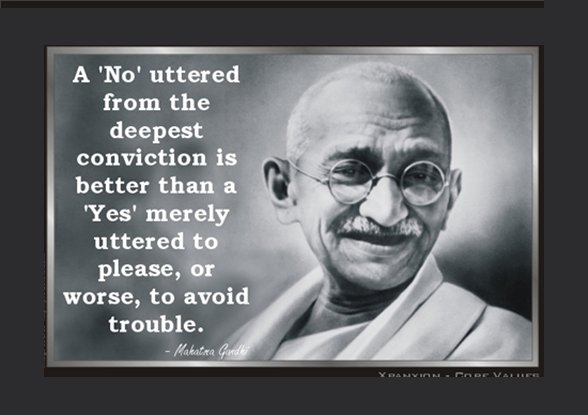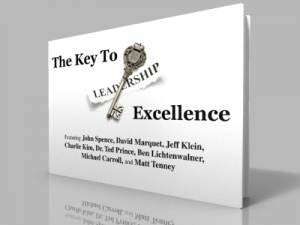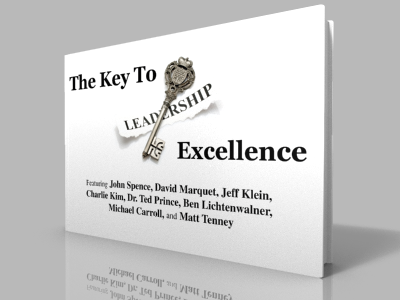How to Be More Authentic – A Simple Step
I recently had an interesting conversation with a friend of mine about my upcoming wedding.
My friend offered a simple, yet powerful tool for being more authentic in our conversations.
I share this story in the video below. Enjoy!
Image credit – www.hartmanhealing.com
Magic Balloons and Building Influence as a Leader

3 Ideas for Being More Charismatic
Great Leaders Listen First
We often think of great leaders as being those people that can get up in front of a group and inspire them with their words. This may be effective in the short term, when the group is new or the leader is new. But leaders who excel over the long term know a simple secret that is quite contrary to the popular leader archetype of being a dynamic speaker.
Great leaders listen first.
Applying this has been very challenging for me. My natural of way relating to others is this kind of arrogant belief that I have all the answers, and I can help everyone by giving them those answers. From this basic starting point, I naturally tend to want to listen very little so I can get on to telling people what I think. Do you ever notice this in your own life?
During my time living and training as a monk, one of the practices I took on was to talk very, very little. The general practice was to speak only to greet people and ask them questions about themselves. I would not say anything about myself or state any opinion or view unless I was directly asked to do so.
One of the effects of this practice is that my mind gradually became much more calm and peaceful. I also noticed that people seemed to enjoy talking to me much more! When we focus more on listening than on talking, we might find that despite saying very little people say of us, “Boy that so and so sure is a great conversationalist!”
There are countless reasons why listening first is so important as leaders. Below are just a few:
- Increases trust, which is vital for effective leadership
- Helps people to feel truly cared for, which improves engagement, retention, creativity, and innovation
- Develops future leaders by encouraging our people to think through problems versus getting the answers from us
- Helps us to leverage the intelligence of our people more because they are more likely to speak up if we haven’t offered our opinions and views first
- Helps us to develop greater mental agility, perhaps the most important trait for today’s managers, by letting go of our conditioned thought patterns
Do you listen first? What are some tools you are applying to be a better listener?
Simple Tools For Creating A Highly Innovative Culture
Simple Tools Applied at HopeLab That Can Help Your Organization to Be More Innovative
Chris Marcell Murchison guides HopeLab’s efforts to create an organizational culture that values learning and innovation. In his 25-year career in the public and private sectors, Chris has focused on staff and organization development. Prior to joining HopeLab, he was with Charles Schwab Corporation in San Francisco, where he was Director of Talent Management and Development after first serving as Senior Manager, Schwab Technology Education, overseeing the development of career development and management development programs.
I recently had the pleasure of interviewing Chris, which you can enjoy as well:
Chris, for those of our readers who have never of heard of HopeLab, could you tell us a little about some of the innovative projects that HopeLab has created?
At HopeLab, we often say we’re harnessing the power and appeal of technology to improve human health and well-being. We use a research-based, customer-focused approach to creating products that are both fun and effective.
Two of our best-known products are Re-Mission and Zamzee. The Re-Mission games are designed to support young cancer patients as they fight their disease. In fact, our research indicates that playing Re-Mission motivates young cancer patients to stick to their medications more consistently, which is a critical part of successful cancer treatment. Our Zamzee product combines an activity meter and a motivational website to inspire tweens to move more. Our research on the Zamzee experience, from a 6-month study, indicated that use of the product can increase physical activity as much as 59%!
A hallmark of HopeLab’s work is the extensive research we do during product development. We engage our end users directly in the development processes and make every effort to ensure that the products we produce will have meaningful impact on health and well-being. HopeLab’s future work will focus on how we can leverage what we’ve learned about motivating healthy behavior to support human resilience. Resilience is actually a great umbrella for all the work we have done to date and I am excited to see what our next big idea will be!
As the VP of staff development and culture, you are responsible for creating a culture that is highly conducive to innovation. Would you share the top three strategies and/or tactics that you employ to make this happen?
Culture is influenced by so many things – values, leadership, relationships, HR policies, etc. We have experimented with all of these and more at HopeLab. Today, I would say that the three most highly leveraged tactics are the following:
- Build the skills and systems to support high quality conversations in the organization – conversations typified by curiosity, authenticity and integrity
- Create an environment in which employees believe they are accountable for the whole of the organization and its success, where they take 100% responsibility for their experience in the organization
- Create work processes and systems that allow individuals and the organization as a whole to experience progress towards meaningful goals
My opinions here are influenced by my experience nurturing culture at HopeLab and my exposure to a wide variety of innovative organizational development and leadership practices. I believe making an intentional investment in building your organization’s culture can enhance your ability to do innovative work and make a positive impact in the world, for your employees and the people your business serves. I continue to learn about the many dimensions of culture every day. As my exposure to other organizations and cultures expands, I am certain my thinking about culture will evolve. I see this as good, because every work community is different and, as a result, there are different levers for catalyzing a thriving culture.
You do a lot to support your people’s well-being. Why do you think it’s so essential for innovation that leaders show their people that they truly care about them, and follow through to ensure that their people actually experience high levels of well-being?
We have a great wellness program at HopeLab. We call it HOGS, which stands for Health and Other Good Stuff, and it is based on the concept of energy management. If we are investing wisely in our physical, emotional, mental and spiritual energy, we are more likely to be purposeful and energized humans. And if as individuals we are engaged energetically, we can collectively create an engaged workplace that has greater potential to accomplish great things!
Additionally, at the core of well-being is resilience – the ability for individuals and organizations to respond positively in the face of change and adversity. The science informing our R&D work indicates that, as humans, cultivating a sense of purpose, connection and control can help us tap into our innate resilience. I think these are powerful insights that can be directly applied to individuals in the workplace. Adversity can take on many forms at work, large and small. A culture that supports employee’s sense of meaning and purpose, helps them connect meaningfully with colleagues, and creates processes where employees have a sense of control and accountability are likely to support well-being as well as enhancing resilience in the face of challenges. And, again, if your employees are engaged, well and resilient, your workplace will be more likely to thrive and innovate.
Not all organizations have access to the levels of funding to which HopeLab has access. What are some low-cost ideas that a leader could apply to show her people she truly cares about them?Culture work does not have to cost anything at all. Ultimately, building an organizational culture is building a community of people. This means attending to how we interact with one another and the quality of our relationships. Investing time and energy at that level, versus dollars, can have a real impact on productivity and job satisfaction.
What does investing in relationships look like? It means making time to authentically connect with others, having quality conversations (in supervision, performance reviews, team meetings, etc.), inviting and offering feedback, listening well, having fun together, participating in meaningful experiences together, and more. In these interactions, so much can be gained from kindness, appreciation, openness, and support – all actions that don’t have to cost anything but your time and attention. I am struck by impact of a simple “good morning” or an expression of true caring. An organization devoid of these basic virtues is, in my opinion, not sustainable.
Improving Social Media Effectiveness With A Human Touch
Customer Service Expert Adrian Swinscoe Helps Us Improve Social Media Efforts With A Human Touch
On your blog, you wrote a great post on the connection between generous and empathetic leaders and high levels of customer service. Could you elaborate a bit on why having empathy and generosity is so important for leaders?
Thank you for your kind words. I think empathy and generosity is important for leaders as I think it is a key part of leading by example, making leadership personal and, thus, being able to better connect with and motivate those that you are trying to lead. This could be as simple as sending less emails and doing fewer meetings and speaking directly with people either on the phone or in person. The keys here are that you are, therefore, being more generous with your time and attention. But to make this as effective as possible you have to have, be able to seek, or be willing to build empathy with everyone that you are talking to. Understanding the other person’s perspective/viewpoint (you don’t have to agree with them) or challenges they face will help leaders build the connections, followers, and insights that leadership requires.
What would you recommend organizations do to better measure how their leaders are doing in this regard?
This is an old idea but I would suggest that organisations revisit the idea of Managing By Walking About (MBWA) and they can measure how they are doing, in this respect, by measuring how much time leaders are spending with customers, with front-line, back-office and operational staff, and what the impact is on overall employee morale and engagement.
You often help organizations strengthen their marketing efforts, especially with social media. How important do you think it is that businesses have a social media component to be able to remain competitive?
There is a piece of research (I forget the source) that says that customer shopping and buying behaviour has dramatically changed over the last ten years. Whilst the trend is applicable across industries the research cites the case of the automobile industry where it states that 10 or so years ago a customer wanting to buy a new car would visit, on average, 8 dealerships. Whereas now they will only visit, on average, 1.2 dealerships in their search for a new car. The implication is that customers are now doing most of their ‘shopping’ online and when they arrive at a car dealership, say, they are ready to buy. Therefore, to be successful and competitive in this changing world, firms need to think about how they are helping their customers or clients, existing or prospective, with their ‘shopping’ journey. Therefore, this has implications for a firms presence and activity in social media, in the broadest sense, and poses challenges for traditional ways of doing business.
What’s a simple way to increase the effectiveness of social media efforts based on this idea of being more empathetic?
A [good] question would be to ask something like: What would you like your customers to say about you to their colleagues, friends, and families? Articulating that would be a great first step in helping the business understand their customers better and build that level of empathy that the modern firm and leader requires. After doing that, the firm will be in a better position to understand how and what type of activity, including social media, is required to deliver that sort of sentiment and advocacy.
How to Become A Level 5 Leader
How to Become What Jim Collins Calls A Level 5 Leader: An Interview With Mary Jo Asmus

A former executive in a Fortune 100 company, Mary Jo Asmus, PCC is the founder and president of Aspire Collaborative Services. She is an executive coach, writer, and consultant who partners with great leaders to help them become even greater at developing, improving, and sustaining relationships with the people who are essential to their success.
A part of your executive coaching work that I find very interesting is that you actually create action plans for helping leaders become “Level 5 leaders,” which are leaders that Jim Collins found through extensive research to be most effective at taking an organization from “good to great.” Could you share your thoughts on why humility and high achievement drive for the greater good are such important qualities of Level 5 leaders?
First of all, I want to make it clear that I don’t create the action plans; the leaders I work with do, with my guidance, based on feedback they’ve received and behavioral goals they are passionate about working on. In a way, this speaks directly to humility (the feedback addresses their “opportunities for development”) and drive (their desire to work on goals that are important to them to help them become great leaders). So we start out with these characteristics of humility and drive from the very start as foundational to the work we do.
Humility is important because it keeps a leader in a learning mindset. The humble leader understands that they don’t know it all, and that they need to count on others to help them. This is important in our fast moving, competitive business world. If a leader doesn’t continually stay in touch with others in order to learn, the pace of change may get ahead of them, causing them to fall behind and ultimately fail.
Drive is important to achieve goals, pure and simple. Leadership is simple in concept, difficult in practice. Very few are actually “born leaders” in my opinion, and it takes significant effort for most to bust through the barriers to become a Level 5 leader. Although I completely understand Jim Collins’ definition of Level 5 leader who is focused on the “greater good” of the company, many of the barriers experienced by a leader in critical stages of their development are self-imposed, requiring a leader to have the energy and ambition to look at themselves with a critical eye and overcome them. This takes a lot of courage and requires an internal focus before a leader can be fully focused on goals for the organization.
Could you share the top three most important ideas you would offer for helping a leader become a Level 5 leader?
1. Get honest feedback often from your stakeholders in a way that they can’t B.S. you (confidential 360 instruments and interviews conducted by a third party are the best way to get this kind of feedback). Find out what behaviors are working and which ones aren’t, and get to work on yourself.
2. Know yourself well. The better you know how you think and react, the better you know what’s important to you, the better you’ll be in a calamity, and you will have at least one of those in your leadership journey.
3. Take care of yourself. Even though a level 5 leader may want to give away everything for the good of the company, if they give away their mental or physical health, they cannot lead well. This requires as much attention to one’s physical and spiritual energy as to their vision and passion for the organization.
Part of your work includes helping leaders move from “me” to “we.” Could you elaborate on what you mean by this?
Most leaders can become better at relationships with those around them. This requires effort, because so many of them have been promoted because they are great at getting things done, but may lack some critical people skills. Getting things done as a lone wolf might work for a while, but at a critical juncture, they realize they can’t do it all themselves. Leadership isn’t a one-person show, and the few times that I’ve seen someone believe that is the case, they’ve burned out or just plain failed. The best leaders I know put people first, knowing that when they’ve developed great relationships and a system of support around them, they’ll be stronger and more successful than they would by themselves.
Why do you think this is so important? Are there specific, measurable business outcomes that you’ve found are more easily achieved by a leader who has moved from “me” to “we”?
How can a leader develop a more self-less, we-centered mentality?
A Powerful Tool For Empowering Your People – Brian Burt, CEO of MaestroConference
A Powerful Tool For Empowering Your People – an Interview with Brian Burt, CEO of MaestroConference
In this interview with MaestroConference CEO, Brian Burt, you’ll learn about some amazing tools for empowering your employees, creating ownership mentality, and having significantly better meetings. This one tool completely transformed the culture at MaestroConference.
At Charles Schwab, Brian led many multi-million-dollar technology projects in the areas of telephone technology, marketing, and CRM systems. He has also led a very successful consulting firm specializing in large technology project leadership, and has co-hosted events with Deepak Chopra, Jack Canfield, Marianne Williamson, and many others. He is a skilled facilitator who also holds a Master’s degree in Mathematics / Mathematical Economics. To learn more about MaestroConference or Brian, please visit: http://maestroconference.com/
To learn more about Holacracy, please visit: http://holacracy.org/
3 Rules for Leading Productive Meetings
Do you walk away from meetings feeling as though your people have provided excellent input and innovative solutions for dealing with the issue at hand?
If not, you may be violating three essential rules for leading productive meetings.

I recently had lunch with one of my mentors and business colleagues, Dr. Ted Prince, founder and CEO of the prestigious Perth Leadership Institute. As a trainer for the Perth Leadership Institute, I always welcome the opportunity to have one-on-one time with Dr. Prince because I usually walk away with some new gem of insight that helps me to be a better trainer and/or to be a better leader.
This recent lunch was no exception. Although at Perth we are focused very intently on helping leaders improve their direct impacts on gross margin and expenses, Dr. Prince spent 20 years leading numerous companies, including a publicly traded company, as a CEO or as a board member, so he also has a lot of wisdom regarding how to deal with people.
During our lunch, the topic of listening came up, which reminded him of three essential rules for running productive meetings, which he had recently taught to some executives he was coaching.
The three rules for leaders to follow if we want to have the most productive meetings are:
- Speak last
- Speak less than 10% of the time
- Don’t offer opinions
Speak Last
As leaders, many of us often think that we’re supposed to be the one with all the great ideas. But great leaders know that to be most effective we need to surround ourselves with people that are smarter than us (which is pretty easy for me) and find ways to get them sharing ideas as frequently as possible. Speaking last is a great way to make sure this happens. When we speak first, we can create unconscious boxes that people might not feel safe deviating from. By making the effort to get our people talking before we share any of our own thoughts, we ensure that we have the best chance of getting fresh new ideas that we might have never heard if we shared our ideas first.
Speak Less than 10% of the Time
When we do speak, it should be at most 10% of the time, and primarily to ask questions of our people. We already know what we think about the topic. The only way we’ll discover solutions that are potentially better than the ones we have is to get our people talking as much as possible. In this way, they are likely to either create a solution or provide some new way of looking at an issue that allows us to arrive at a solution that we never would have seen had we tried to do it all on our own.
Don’t Offer Opinions
Our goal should be to create an environment where people feel really safe to share whatever ideas they have. The moment we start offering opinions about the topic in general or, worse, an idea shared by our people, we increase the level of fear people will have about sharing their ideas, and decrease the likelihood that we will get truly innovative solutions from our people.
Do you follow a version of these three rules when you lead meetings with your people?
Did you like this post? To receive The Ultimate Leaders E-Zine for FREE, just Click Here. It includes all my blog posts, interviews with great leaders, and other resources to help you become the Ultimate Leader.














